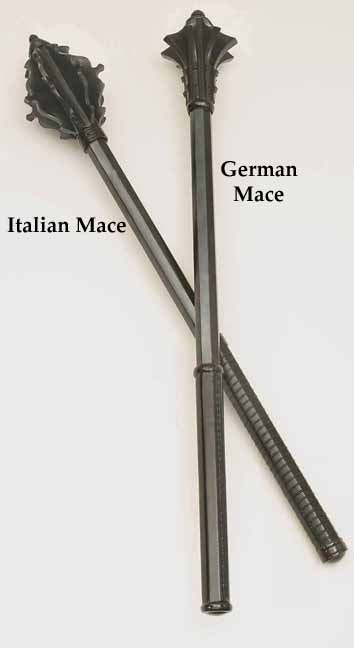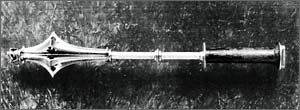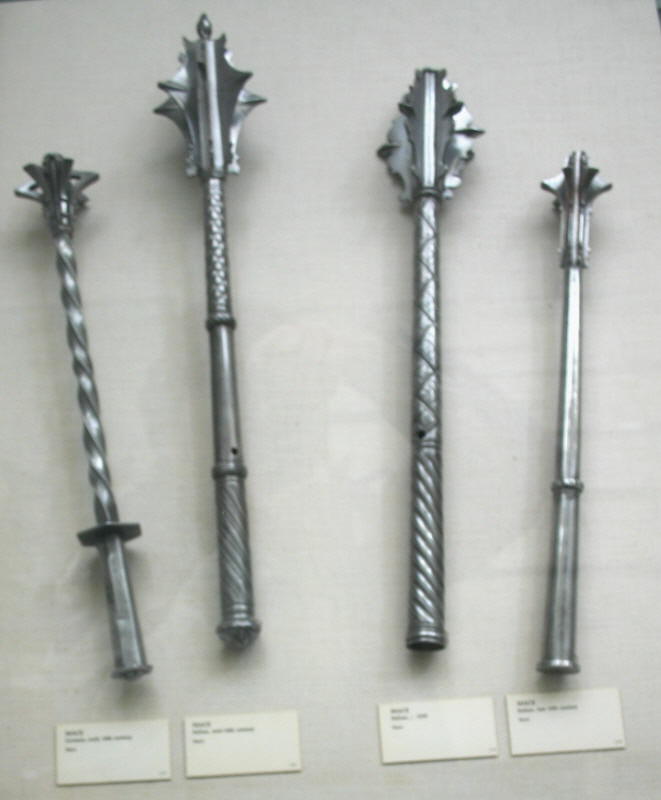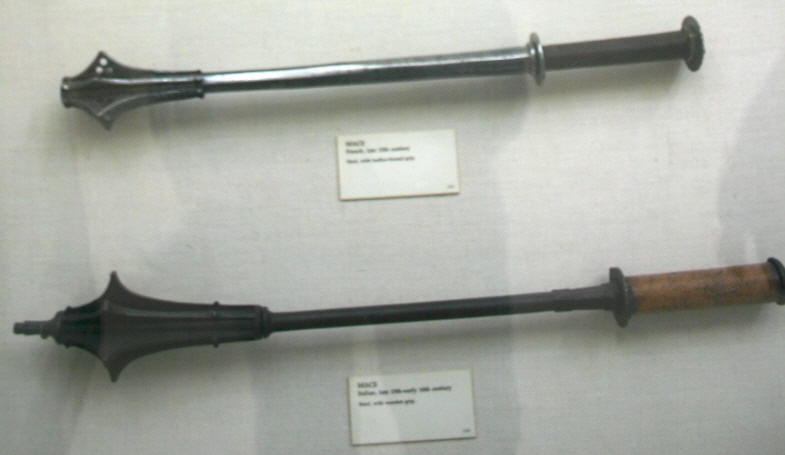| Author |
Message |
Sean Flynt

|
 Posted: Tue 13 Dec, 2005 8:29 am Post subject: Mace ID? Posted: Tue 13 Dec, 2005 8:29 am Post subject: Mace ID? |
 |
|
MRL has two new maces, called "Italian" and "German". I know the Italian is a 16th c. type. I need help with the German mace. Dürer shows a mace of similar proportions in the far background of a woodcut of 1496-1500. The type looks like a simplification of the fully-formed gothic maces of the last half of the 15th c., which suggests that it may indeed be a transitional German type of ca. 1500. The problem is that I can't find any photos or contemporary depictions of similar maces (simpler, smallish head, thick shaft, long grip, vestigal gaurd)-not in my library, not online. Can anybody confirm that this mace could have at least been used past 1500? Is that a reasonable assumption?
 Attachment: 24.28 KB Attachment: 24.28 KB

-Sean
Author of the Little Hammer novel
https://www.amazon.com/Little-Hammer-Sean-Flynt/dp/B08XN7HZ82/ref=sr_1_1?dchild=1&keywords=little+hammer+book&qid=1627482034&sr=8-1
|
|
   |
 |
Joachim Nilsson

|
 Posted: Tue 13 Dec, 2005 2:27 pm Post subject: Posted: Tue 13 Dec, 2005 2:27 pm Post subject: |
 |
|
|
Bells are ringing like crazy in my head right now, but I can't quite put my finger on.... it. I'll get back to you ASAP.
|
|
 |
 |
Nathan Robinson
myArmoury Admin


|
 Posted: Tue 13 Dec, 2005 2:32 pm Post subject: Posted: Tue 13 Dec, 2005 2:32 pm Post subject: |
 |
|
I've not enough time to put a thoughtful response together, but I'll take this opportunity to post a few things and you can sort through what is of interest to you.
"Gothic" mace, German, circa 1480

Click photo for full-size version
German, circa 1460-1490

Click photo for full-size version
German, circa 1520

Click photo for full-size version
All from the middle of the 16th century.
Top to bottom: Northern Italian, German (?), German, German (?)

Click photo for full-size version
Italian, circa 1500, The Wallace Collection

Click photo for full-size version
Likely German, second half of the 15th century

Click photo for full-size version
.:. Visit my Collection Gallery :: View my Reading List :: View my Wish List :: See Pages I Like :: Find me on Facebook .:.
|
|
    |
 |
Joachim Nilsson

|
 Posted: Tue 13 Dec, 2005 2:49 pm Post subject: Posted: Tue 13 Dec, 2005 2:49 pm Post subject: |
 |
|
|
Oakeshott pegs the type as a late-fiftenth-century type on page 66 in his book European Weapons and Armour: From the Renaissance to the Industrial Revolution. On page 100 of the same book he features a photograph of a similar mace which he dates to c. 1460-1490.
|
|
 |
 |
Sean Flynt

|
|
   |
 |
Thomas McDonald
myArmoury Alumni


|
 Posted: Tue 13 Dec, 2005 6:18 pm Post subject: Posted: Tue 13 Dec, 2005 6:18 pm Post subject: |
 |
|
Just to throw up a couple more ....
A few mace on display at the Burrell Collection, Glasgow. (sorry, my auto-focus has a mind of its own ;-)
Mac
Photos: T. McDonald, 2005.
 Attachment: 41 KB Attachment: 41 KB

 Attachment: 29.34 KB Attachment: 29.34 KB

|
|
   |
 |
Sean Flynt

|
|
   |
 |
|
Russ Ellis
Industry Professional
|
|
  |
 |
Sean Flynt

|
 Posted: Wed 14 Dec, 2005 11:17 am Post subject: Posted: Wed 14 Dec, 2005 11:17 am Post subject: |
 |
|
A closer read of Oakeshott and some elementary mathematics revealed that maces of his "M2" type were sometimes over two feet long and over six lbs! Can you imagine how much force you could generate with that length and weight. How many foot-pounds of pressure do you reckon would be concentrated in the tip of one of those flanges at contact? It'd crack your coconut good and proper, no doubt. The MRL German mace, by the way, is listed as two feet long and four pounds, which is about right for the M2 maces of the 16th c. That seemed monstrously long and heavy to me until I took a closer look at Oakeshott. Yikes! So, I think my question is mostly answered. This seems to be either an M2 mace of the early 16th c. or a transitional type of ca. 1500.
-Sean
Author of the Little Hammer novel
https://www.amazon.com/Little-Hammer-Sean-Flynt/dp/B08XN7HZ82/ref=sr_1_1?dchild=1&keywords=little+hammer+book&qid=1627482034&sr=8-1
|
|
   |
 |
Jean Thibodeau

|
 Posted: Wed 14 Dec, 2005 1:49 pm Post subject: Posted: Wed 14 Dec, 2005 1:49 pm Post subject: |
 |
|
The A & A version is stated to be 2.8 pounds which should be fast and not impossibly tiring to use for any period of time.
What you might loose in mass you gain in speed and I wouldn't want to be hit by one no matter how good a helm I had on.
Maybe there is a range between too light or boat anchor heavy.
Hmmmm ..... A & A Flanged mace or War hammer ...... what to buy .... what to buy.  
You can easily give up your freedom. You have to fight hard to get it back!
Last edited by Jean Thibodeau on Wed 14 Dec, 2005 5:17 pm; edited 1 time in total
|
|
  |
 |
Thomas McDonald
myArmoury Alumni


|
 Posted: Wed 14 Dec, 2005 1:59 pm Post subject: Posted: Wed 14 Dec, 2005 1:59 pm Post subject: |
 |
|
| Sean Flynt wrote: | | Mac! You did it! The mace at far right in the first photo is exactly what I'm looking for. Do you have any other shots that might reveal the text/date on the placard? If not, I can contact the Burrell folks. Many thanks! |
Hi Sean
Unfortuately I did not take any other shots of this mace display, which is in the European Daylight Gallery, as I was supidly (as it turned out) trying to conserve space on my flashcard for behind the scenes stuff !
I did some playing around with the image and was able to read Mace-14th-15th century ...... but I just can't make out the country of origin with any certainty ?
I did shoot a few nice ones in the reserve downstairs, one which seems similar in length, head, etc., but the ID cards only give catalog numbers and that they belong in the Euro Daylight Gallery display ?
I'm sure the Burrell would be happy to give you information on it !
Good luck, Mac
|
|
   |
 |
Sean Flynt

|
 Posted: Wed 14 Dec, 2005 2:04 pm Post subject: Posted: Wed 14 Dec, 2005 2:04 pm Post subject: |
 |
|
Oakeshott asserts that the gothic maces were smaller and lighter than both earlier and later maces, so the weight of the AA (as well as MRLs other gothic maces) seems right for the type. Those of ca. 1460-1490 seem to be in the 18-20" range, while the later M2 maces of the 16th c. are in the 24-26" range. That's hanger length! I'm thinking that the long grip of some later examples would allow one to "choke up" as needed to manage the weight. I was surprised to learn that the shafts typically were hollow. So, although it looks like the shafts would add a great deal of weight they're actually lighter than they look, pushing the balance out toward the head. I don't know if AA or MRL use hollow or solid shafts, but that could make a significant difference in handling and impact.
When I get mine, I'm going to ditch the all-black look.
-Sean
Author of the Little Hammer novel
https://www.amazon.com/Little-Hammer-Sean-Flynt/dp/B08XN7HZ82/ref=sr_1_1?dchild=1&keywords=little+hammer+book&qid=1627482034&sr=8-1
|
|
   |
 |
Sean Flynt

|
 Posted: Wed 14 Dec, 2005 2:13 pm Post subject: Posted: Wed 14 Dec, 2005 2:13 pm Post subject: |
 |
|
| Thomas McDonald wrote: | | I did some playing around with the image and was able to read Mace-14th-15th century ...... |
Strange...I'd say it's late 15th at the earliest, and I'm almost certain that some of those with it are early 16th c. It's possible they've just got it wrong but I don't know enough to say for sure. I recently visited a museum collection of Scottish basket hilt swords that would have had you howling, Mac. Dates were all over the place and some were obviously wrong. I suspect that what happened in that case is that the museum acquired those weapons many, many decades ago and simply recorded what the original collector told them about the pieces. Maybe I'll get in touch with the Burrell folks in coming weeks. Thanks again for the info!
-Sean
Author of the Little Hammer novel
https://www.amazon.com/Little-Hammer-Sean-Flynt/dp/B08XN7HZ82/ref=sr_1_1?dchild=1&keywords=little+hammer+book&qid=1627482034&sr=8-1
|
|
   |
 |
|
|

